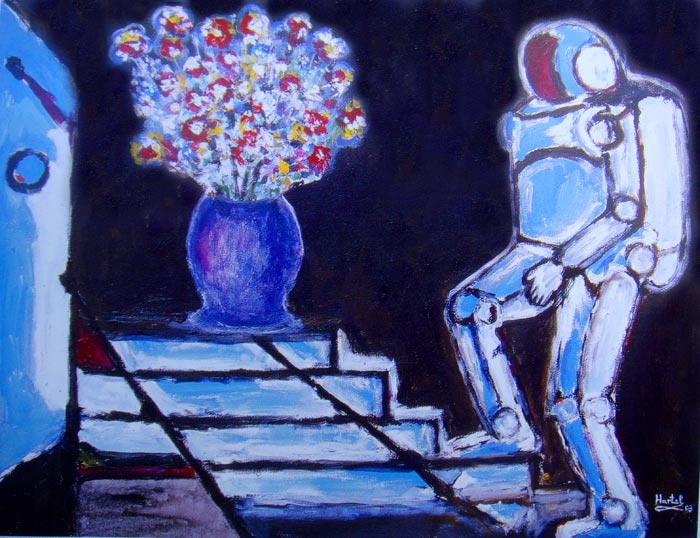Part 3 of 5. Read the previous part… by Paul Hartal.
Chapter 3: A Leap of Imagination
Einstein’s theories rely on innovative mathematical models of space. For more than two millennia the magnificent geometrical axioms of Euclid of Alexandria were regarded as incontrovertibly absolute truths. New discoveries transformed their status, although inasmuch as the axioms apply to the geometrical properties of flat objects, they are still valid today and continue to be part of the school curriculum.
In the 19th century non-Euclidean geometries challenged Euclid’s Elements, revealing the slippery foundations of mathematics. The new geometries grew out from the discoveries of Gauss, N.I. Lobachevski (1792-1856), János Bolyai (1802-1860) and Bernhard Riemann (1826-1866). In contrast to the Euclidean flat plane, in non-Euclidean geometry events occur in curved space. Unlike on the two-dimensional Euclidian surface where through a point, lying outside of a line, only one parallel to the given line can be drawn, in the saddle-shaped hyperbolic space of Lobachevski and Bolyai several parallel lines might pass by. While in Euclidean space the sum of angles in a triangle always amounts to 180 degrees, in hyperbolic geometry that sum always falls short of 180 degrees.
In the elliptic space of Riemannian geometry the sum of angles in a triangle always exceeds 180 degrees. The simplest model of Riemann’s non-Euclidean geometry is the sphere. Contradicting Euclid, Riemann postulates that a straight line cannot be lengthened into an infinitely long line. He also rules that great circles in spherical space intersect and thus here parallel lines cannot exist. Like the meridians of the globe, great circles on a sphere meet at the poles.
While on a flat surface the shortest distance between two points is a straight line, on a sphere it is a geodesic curvature. Consequently, the shortest route to fly in an airplane from Paris to Tokyo, for example, follows a curved line.
In 1915 Einstein applied Riemann’s geometry to the General Theory of Relativity. This was a courageous leap of imagination, the creative act of a great artist. Einstein envisioned a four dimensional map of an elliptic universe in which the gridlines are light beams.

Figure 4: ‘Robot with Flowers’, Acrylic on canvas, 71 cm x 56 cm, 2003 (Collection of Hanseo University Art Museum, Seoul).
Can an automatically guided computational machine evolve into a sentient trans-human organism? The robot approaching the vase and the flowers takes an uncommon flight of steps because the stairs in the image are not drawn in conventional geometric perspective but in non-Euclidean hyperspace, offering simultaneous front and side views.
Although light travels in straight lines, gravitation resulting from the curvature of space-time bends it. Matter and energy in the universe force the space-time fabric of the universe to curve and matter moves in accordance with the cosmic topography. So, Einstein’s gravitational force governing the motion of inertial objects is the consequence of the elastically bending space-time that tells matter how to move in curved space.
Astronomical evidence for the General Theory of Relativity came from observations of Mercury, the innermost and smallest planet in the Solar System. Prior to 1915 astronomers could not explain what caused the slight perturbations in Mercury’s orbit nearest to the Sun. Newton’s Theory of Universal Gravitation could not account for the discrepancy in the perihelion shift of the planet. Now, the General Theory of Relativity provided a satisfactory explanation for the irregular motion of the planet.
The first experimental probe that confirmed Einstein’s new physics took place in 1919 on Principe, an island lying off the west coast of Africa. On May 29, during a total solar eclipse, Sir Arthur Eddington (1882-1944) performed a trial showing that starlight bends as it passed by the Sun. The finding turned Einstein into a celebrity overnight, cementing his position as the greatest scientist of the era. Moreover, it ensured the triumph of the Theory of Relativity over classical Newtonian physics.
In 1927 Werner Heisenberg (1901-1976) shocked the world of physics by enunciating the uncertainty principle, an intrinsic restriction on the scientific accuracy of measurement in small scale systems. In theory a particle of an atom always has to be somewhere traveling at a certain speed. Yet Heisenberg found that due to the wave properties of matter on the atomic level it is impossible to define simultaneously a particle’s position and momentum. While measuring the position the momentum becomes unfixed and in trying to define the momentum the position is lost.
This forces the physicist to resort to calculate probabilities for the location and speed of subatomic particles. Schrödinger’s equation describes the particle’s infinite possibilities to spread out as a wave to anywhere or at anytime until it settles in a location or at some moment. When one of the possibilities of the particle actualized, all other possibilities vanish and Schrödinger’s wave function collapses.
In the strange world of Quantum Theory the famous thought experiment of Schrödinger’s Cat deals with the paradox of simultaneously being dead and alive. The experimenters place a cat into a box equipped with an instrument in which electrons can trigger either the delivery of nourishing food or the flow of a deadly poison gas. However, the cat is a quantum cat governed by the wave function equation. Quantum Physics asserts that we live in a participatory universe and thus consciousness forms an integral part of nature.
Consequently, observation in Quantum Mechanics plays a central role in the outcome of an experiment, leading to the collapse of the wave function. When the experimenters open the box they will find the cat either alive or dead. However, if they do not look they can calculate only probabilities, a mathematical process in which the cat is both dead and alive at the same time (11).
16 July 2010.
© Paul Hartal, Montreal, Canada.
References (for part 3)
11. John Gribbin, In Search of Schrödinger’s Cat: Quantum Physics and Reality, New York: Bantam Books, 1984


 - Reading with Natalie, book here...
- Reading with Natalie, book here...